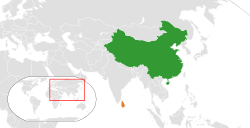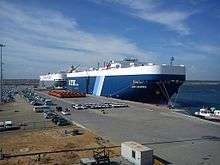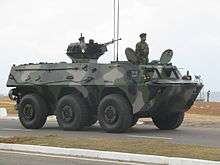China–Sri Lanka relations
 | |
China |
Sri Lanka |
|---|---|
The China–Sri Lanka relations refers to bilateral relations between the People's Republic of China and Democratic Socialist Republic of Sri Lanka. There is a Chinese embassy located in Colombo and a Sri Lankan embassy situated in Beijing. Historical and cultural ties between the two countries extend back hundreds of years.[1] [2]
Relations between both countries during the rule of Sri Lankan president, Mahinda Rajapaksa, resulted in many agreements and saw closer relations due to Rajapaksa's pro-China stance.[3] Under current Sri Lankan president, Maithripala Sirisena, relations remain strong with Sirisena interested in balancing both Chinese and Indian influence in the country.[4][5] Despite this, recent developments have shown a "pro-China" slant to Sri Lanka's current foreign policy evident in the continued Chinese investment in Sri Lanka and the country's support of China's position in the South China Sea dispute.[6][7][8]
Sri Lanka is a major country on the String of Pearls which is part of the Chinese strategic initiative in the Indian Ocean, known as the Maritime Silk Road and is part of the bigger development strategy known as the One Belt, One Road.[9]
History

Faxian traveled to Sri Lanka in 410 and resided in the country for two years before returning to China in a merchant ship. The Karanamudra Sutra and Vimuttimagga, two Buddhist texts in Sri Lanka, were translated to Chinese in 489 and 505 respectively. Amoghavajra, a powerful Buddhist monk in Chinese history traveled to Sri Lanka and was responsible for translating the Karandamudra Sutra into Chinese and taking it back to China in the 8th century. Buddhist nuns from Sri Lanka, vice versa, traveled to China in 429 and 433.[10][11]
Chinese/East Asian architecture, alongside Indian architecture, was one of the main foreign influences on Sri Lankan architecture and played a significant role in shaping it.[12]
The form of martial art known as Cheena di from Sri Lanka derives from Chinese influence via Shaolin monks who arrived to the island on pilgrimage and taught it to the Sinhalese people.[13][14]
The Simha which is found standing outside Buddhist temples and other buildings throughout Sri Lanka is a variation of the Chinese guardian lion.
During the Ming dynasty in the Yongle Emperor's reign, Admiral Zheng He's Treasure voyages visited Sri Lanka and fought in the Ming–Kotte War.[15] The Galle Trilingual Inscription was erected in Galle, Sri Lanka in 1409 to commemorate Zheng He's second visit to the country.[16] Sri Lanka was a tributary state of the Ming dynasty for many years and it was during this period that Chinese influence most impacted Sri Lankan politics and commerce.[17][18]
Like many other parts of East, South and Southeast Asia, Chinese immigrants migrated to Sri Lanka during the 18th and 19th centuries, albeit in much smaller numbers in comparison to neighbouring countries like India, Myanmar or other parts of Southeast Asia.[19] As of the 2001 census, they comprise less than 0.20% of the population and have integrated into broader Sri Lankan society.[20]
Diplomatic Ties
Sri Lanka was among the first countries to recognize the People’s Republic of China. Since then, the two countries have regularly exchanged high-level visits resulting in a variety of agreements. China has provided economic, military and technical assistance to Sri Lanka.
There is substantial investment from China in Sri Lankan infrastructural expansion. From 2004 to 2014, China provided 7 billion dollars in loans,[21] including loans for the construction of a Sri Lankan port in Hambantota. However there are concerns inside the country and in the international media that Sri Lanka cannot afford these loans since the nation is already 64 billion dollars in debt, and about 95% of the government's revenue is used to pay back loans.[22] In the case of the port in Hambantota, the two countries have recently come to a deal with Sri Lanka selling a majority stake in the port to the state-run China Merchants Port Holdings, while Sri Lanka retains control of port security.[23] China and Sri Lanka also share a military relationship, with China selling a range of modern armaments to the Sri Lanka Armed Forces.
Defense ties

China has been a continuing source of military equipment to Sri Lanka, and is helping to modernize and expand the Sri Lanka Armed Forces. China exports military equipment to the Sri Lanka military including: ammunition, anti-tank guided missiles, rocket launchers and shoulder-fired surface-to-air missiles, deep penetration bombs and rockets, mortar ammunition, night vision devices, artillery, armor, mortars, security equipment, tanks, jets, naval vessels, radars, and communications equipment. China also aids in the training of Sri Lankan military personnel.[24]
China National Aero Technology Import-Export Corporation is helping the Sri Lanka government to create an Aircraft Maintenance Centre. However, the location has not yet been finalised, but Katunayake, Mattala and Trincomalee are possible locations.[25]
Chinese nuclear submarines have made several visits to Sri Lanka in September and November 2014, despite strong displeasure from the Indian government.[26]
In October 2016, the Chinese government announced it would offer military aid to Sri Lanka to help them purchase Chinese made military equipment.[27]
Chinese expatriates in Sri Lanka
Chinese international students, migrant workers, and business people have moved to the country in the 1990s and 2000s.[28][29] In recent years, Chinese engineering companies who have been contracted for projects in Sri Lanka have also brought in migrant workers from China. The earliest such workers came in 1970 to work on the Bandaranaike Memorial International Conference Hall. More recently they are working on infrastructure projects at Hambantota, such as the Hambantota International Airport and the Port of Hambantota.[30] The port project, run by China Harbour Engineering Co Ltd, was reported to employ 328 Sri Lankan and 235 Chinese workers in 2008.[31] Due to the influx of Chinese workers, Hambantota locals have even begun doing business growing and selling Chinese vegetables such as Chinese cabbage, choy sum, and kale for their kitchens.[32] The Norocholai Power Station, a fossil fuel power station construction project near Puttalam, reportedly employs 900 Chinese engineers, helpers, welders, and fitters, with the assistance of only a few Sri Lankans.[33][34] Other construction projects known to employ Chinese workers include the Colombo National Performing Arts Theatre (reported to employ 1,000 Chinese workers) and a water-supply upgrade project in Colombo run by China Geo Engineering Corporation.[35][36]
Modern cultural ties
Sri Lanka has become a very popular destination for Chinese tourists and now form the largest nationality of tourists coming to the country. In the first seven months of 2016, 1,173,618 Chinese tourists visited the country.[37] Almost 1.8 million visited in 2015.[38]
Chinese cuisine enjoys a lot of popularity in Sri Lanka and like Indian cuisine, restaurants serving Chinese cuisine can be found across the island.[39]
Sinhalese language-dubbed Chinese and Hong Kong television dramas are popular and are broadcast on major television networks in Sri Lanka; subtitled copies are sold in DVD stores across the country as well.[40] Chinese action films are popular and in the past enjoyed a lot of popularity in the country with CD stores across the country supplying the DVDs.[41] Additionally, Chinese-origin TV channels and radio stations have begun broadcasting in the country including: China Central Television, China Radio International and Celestial Movies.[42]
References
- ↑ http://www.sundayobserver.lk/2017/11/12/features/bri-and-buddhist-kingdom-lanka
- ↑ http://ar.unesco.org/silkroad/sites/silkroad/files/knowledge-bank-article/china_sri_lanka_trade_and_diplomatic_relations_including_the_voyages_of_cheng_ho.pdf
- ↑ Rising China's Influence in Developing Asia
- ↑ Indian Ocean: China, Sri Lanka keen to push Colombo port project
- ↑ Sri Lanka attempts tricky maritime balancing act
- ↑ President Sirisena’s second visit to Beijing to boost China-Sri Lanka ties
- ↑ Sri Lanka to support China over South China Sea issue with Philippines
- ↑ U.S. should stop intervention in South China Sea issue: Sri Lankan official
- ↑ http://www.sundayobserver.lk/2017/11/12/features/bri-and-buddhist-kingdom-lanka
- ↑ https://books.google.com.au/books?id=Vt3zDQAAQBAJ&printsec=frontcover#v=onepage&q&f=false
- ↑ http://www.sundayobserver.lk/2017/11/12/features/bri-and-buddhist-kingdom-lanka
- ↑ The Oxford History of the British Empire: Volume V: Historiography, pg 248
- ↑ http://archives.sundayobserver.lk/2006/09/24/zin02.asp
- ↑ https://web.archive.org/web/20171210022437/http://www.mardb.com/cheena-di/
- ↑ http://www.sundayobserver.lk/2017/11/12/features/bri-and-buddhist-kingdom-lanka
- ↑ http://www.china.org.cn/english/features/zhenhe/134661.htm
- ↑ http://www.lse.ac.uk/economicHistory/Research/GEHN/GEHNPDF/GEHNWP21-GA.pdf
- ↑ http://www.island.lk/2002/06/15/satmag01.html
- ↑ Armstrong, Armstrong & Mulliner 2001, p. 32
- ↑ Jayasuriya, S. de Silva (2000). The Portuguese Cultural Imprint on Sri Lanka. Lusotopie 2000. p. 255.
- ↑ "Sri Lanka snubs India, opens port to Chinese submarine again - Times of India". The Times of India. Retrieved 2017-08-04.
- ↑ Limaye, Yogita (2017-05-26). "Sri Lanka: A country trapped in debt". BBC News. Retrieved 2017-08-04.
- ↑ "Exclusive: Sri Lanka's cabinet 'clears port deal' with China firm after concerns addressed". Reuters. 2017-07-25. Retrieved 2017-08-04.
- ↑ archive.indianexpress.com/news/china-to-train-sri-lankan-army-to-provide-military-technology/1123290/
- ↑ http://www.ceylontoday.lk/51-68802-news-detail-chinese-aircraft-maintenance-centre-in-trinco.html
- ↑ http://timesofindia.indiatimes.com/india/Sri-Lanka-snubs-India-opens-port-to-Chinese-submarine-again/articleshow/45008757.cms
- ↑ China strengthens military trade ties with Cambodia and Sri Lanka
- ↑ Chelvaratnam, Rajika (2003-01-26), "Migrant Chinese businessmen - a dying breed?", Sunday Times, retrieved 2011-06-14
- ↑ "斯里兰卡高教部长祝贺中国留学生学成回国", China Review News, 2009-03-23, retrieved 2011-06-14
- ↑ "Shadows of Asian giants over Sri Lanka", The Sunday Leader, 2010-09-05, retrieved 2011-06-14
- ↑ "Chinese, Sri Lankan workers mingle at sprawling Hambantota port site", The Sunday Times, 2008-10-05, retrieved 2011-06-14
- ↑ "Novel project in Hambantota: Lankan grown Chinese vegetables", Sunday Observer, 2010-05-09, retrieved 2011-06-15
- ↑ Kannangara, Ananda (2010-11-21), "Power at Rs. 8.04 a unit from next year - Minister Patali Champika Ranawaka", Sunday Observer, retrieved 2011-06-15
- ↑ Berenger, Leon (2009-10-25), "Chinese workers at Coal Power Project threatened", The Sunday Times, retrieved 2011-06-14
- ↑ Hemachandra, Lakmali (2010-09-05), "Chinese company work on arts theatre 'not abandoned'", The Nation, retrieved 2011-06-15
- ↑ "Sri Lanka water supply expansion contract to Chinese firm", Express Business, 2010-11-01, retrieved 2011-06-15
- ↑ http://news.xinhuanet.com/english/2016-08/05/c_135567195.htm
- ↑ http://www.chinadaily.com.cn/travel/2016-07/05/content_25975133.htm
- ↑ https://books.google.com.au/books?id=6QAgHA69_rwC&printsec=frontcover#v=onepage&q&f=false
- ↑ Example of a Chinese drama broadcast in Sri Lanka in 2013.
- ↑ http://nation.lk/online/2017/03/04/so-royal-and-regal.html
- ↑ http://www.sundaytimes.lk/100613/Magazine/sundaytimestvtimes_2.html
Bibliography
- Armstrong, M. Jocelyn; Armstrong, R. Warwick; Mulliner, K. (2001), Chinese populations in contemporary Southeast Asian societies: identities, interdependence, and international influence, Routledge, ISBN 978-0-7007-1398-1
.svg.png)
